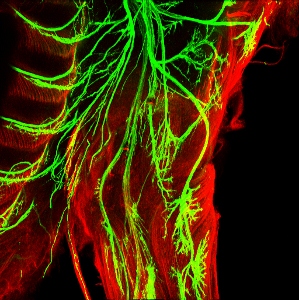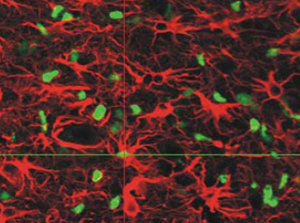
Going the distance. Motor neurons (green) innervate into the muscles of the growing mouse forelimb. Courtesy of Jeremy Dasen, PhD, New York University School of Medicine.
More than 70% of motor neurons in the spinal cord degenerate in people with ALS just one year after being diagnosed with the disease. To turn the tide of motor decline, researchers are developing stem cell-based strategies to regenerate the deteriorated motor nerves.
But some ALS experts worry that such strategies may simply take too much time to be effective. Motor neurons could take by some estimates years to extend and plug back into muscles. The same time many people with ALS battle and ultimately die of the disease.
Researchers at Johns Hopkins School of Medicine introduced in 2008 another option. Healthy astrocytes are created in the cervical spinal cord to protect remaining motor neurons in the diaphragm from degeneration. The strategy, currently being developed in mice, is thought to work in part by reducing levels of glutamate in the central nervous system which at high levels can kill motor nerves.
Reporting in 2008, the team found that such a strategy reduced motor decline and increased survival of mice with an ALS-like disease 11%.
“We thought that it would be clinically more feasible to introduce astrocytes when compared to motor neurons and re-establishing all those neuronal connections,” explains Johns Hopkins School of Medicine neurologist Nicholas Maragakis MD.
Now, the Johns Hopkins team reports that such a strategy using human astrocyte precursors appears to generate astrocytes in the cervical spinal cord but does not offer neuroprotection in ALS mice.
The study is published this month in PLoS One.
Scientists implanted healthy human astrocyte precursors into the cervical spinal cord of mice with an ALS-like disease. The team found these cells developed into astrocytes. But the scientists observed no difference in life expectancy.

Transplantation post-op. Researchers transplanted healthy human astrocyte precursors (green) which subsequently differentiated into astrocytes (red) in the spinal cord of mice with an ALS-like disease. Here, a section of the spinal cord is shown at end-stage. Adapted from Lepore, A.C. et al. (2011) PLoS One, 6(10): e25968.
The reason, suspects Maragakis, is that these transplanted cells simply did not have enough time to develop into astrocytes and protect the motor nerves from deteriorating. The team reported as few as 50% of cells developed into astrocytes in mice at the end-stage of disease.
“Human cells mature much more slowly,” explains Maragakis. “I think it just might take longer to get that [neuroprotective] effect.”
The team is now taking a look at mice with a more slowing progression form of an ALS-like disease to determine whether or not these strategies given enough time could protect the motor nerves from degeneration.
Looking ahead, the team hopes to develop transplantation strategies using astrocytes generated from the patients themselves to eliminate the need for immunosuppressive medications. But the researchers caution that astrocytes created using existing reprogramming technologies may not be exactly the same as native astrocytes. And even more importantly, re-introducing cells from people with ALS may instead contribute to the disease.
“It may be that a patient getting back his or her own cells may not be a good thing,” says Maragakis, “particularly for those with genetic forms of the disease.”
Meanwhile, researchers from BrainStorm Cell Therapeutics in Israel are developing a different strategy to prevent further deterioration of the motor nerves. Astrocyte-like cells derived from patients’ bone marrow are genetically modified to produce substances including glial cell-derived neurotrophic factor (GDNF) which protect the motor nerves. Called NurOwn, this strategy is currently being evaluated in Israel in an open label phase I/II trial. First results are expected in early 2013.
References
Lepore, A.C., O'Donnell, J., Kim, A.S., Williams, T., Tuteja, A., Rao, M.S., Kelley, L.L., Campanelli, J.T., and Maragakis N.J. (2011) Human Glial-Restricted Progenitor Transplantation into Cervical Spinal Cord of the SOD1 Mouse Model of ALS. PLOS One, 6(10), e25968. Abstract | Full Text
Lepore, A.C., Rauck, B., Dejea, C., Pardo, A.C., Rao, M.S., Rothstein, J.D., and Maragakis, N.J. (2008). Focal transplantation-based astrocyte replacement is neuroprotective in a model of motor neuron disease. Nature Neuroscience, 11(11), 1294-1301. Abstract | Full Text
Further Reading
Maragakis N.J. (2010). Stem cells for the neurologist. Amyotrophic Lateral Sclerosis, 11(5), 417-423. Abstract | Full Text (Subscription Required)